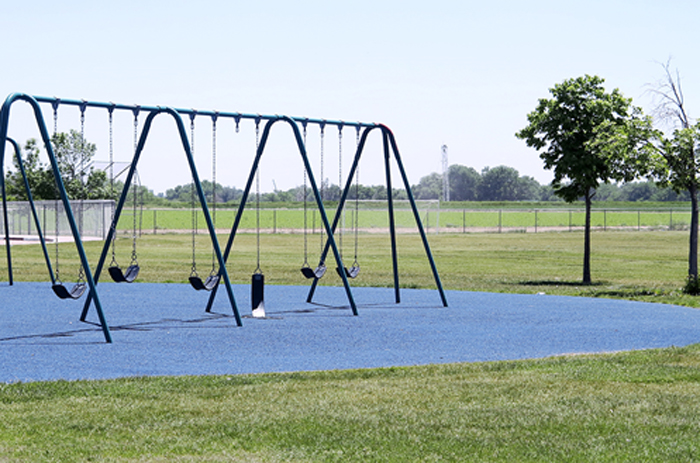
The playground at Bella Romero Adacemy in Greeley, Colorado, with the proposed oil and gas development site visible just beyond the fence. Photo courtesy of the Fracktracker Alliance.
As Sierra Club staff described in detail in a July 2016 blog post, the COGCC’s decision to permit this development not only demonstrates a reckless disregard for human health and welfare; it is also an egregious example of environmental injustice. The student population at Bella Romero is more than 87% Latino or Hispanic, African American, or other people of color.[4] This stands in stark contrast with the student population of Frontier Academy, the original proposed location for Extraction’s development. Back in 2013, Extraction was awarded a permit to drill up to 67 wells a few hundred feet from the grounds of Frontier Academy, but following strong resistance from local parents Extraction withdrew those plans and, in May 2016, filed a new application for the site -- next to Bella Romero.
While we certainly would not like to see oil and gas development adjacent to Frontier, Bella Romero, or any school, for that matter, this location change lays bare the environmental justice issues at play. Whereas Bella Romero’s student population is composed almost entirely of students of color and nearly 92% of students qualify for free or reduced price lunch,[5] about 77% of students at Frontier identify as white, and only about 20% qualify for free or reduced price lunch.[6] Adding insult to injury, Extraction has stated that the reasoning behind the location change was that the Frontier Academy site was “not ideal” for oil and gas development because of its proximity to the school and playground. This all seems fair enough, except that the approved site is actually closer to Bella Romero’s facilities than it was to those at Frontier. As stated in the Sierra Club lawsuit, “the Commission and operators generally experience the least amount of pushback when siting major oil and gas development in predominantly minority communities since these communities do not have the same resources as more affluent communities.” By filing this lawsuit, Sierra Club and the other plaintiffs are hoping to level the playing field against Extraction.
Although drilling is not expected until 2019, Extraction began construction activity at Bella Romero in mid-February, 2018. Unfortunately for Extraction, however, the community is rising up in support of the Bella Romero students. Local families and community groups have been flooding the COGCC with comments against the development, speaking out at hearings, organizing rallies, and more. In February a group of parents and activists held a rally protesting the development and last June a group of environmental advocates held a prayer circle for the children of Bella Romero Academy. Just a few weeks ago, on the morning of March 8, independent protesters arrived at the construction site and draped a banner reading “People Over Pipelines” over a bulldozer. Several of the protesters were charged with trespass and one man was arrested after chaining himself to the bulldozer and refusing to leave.
The high level of frustration and resistance rising up from the community is further supported by Extraction’s dismal safety record. According to a report by Fractracker, the company ranks 51st of 305 oil and gas operators in Colorado for number of violations. While some of these violations are relatively minor, they have also included a number of explosions, emergency evacuations, and toxic releases into air and water. For example, on December 22, 2017, the very day Sierra Club’s lawsuit was heard in court, an explosion at an Extraction oil and gas drilling site in Windsor, Colorado, left a worker injured and prompted the evacuation of a nearby home. Firefighters were forced to work through the night to contain the resulting fires less than 15 miles from Greeley.
It is unclear when a decision will be handed down on the pending lawsuit, but it is our hope that the courts will come down on the side of justice and equity and vacate the COGCC’s approval of Extraction’s plans to frack where children learn and play. Children deserve to feel safe at school, regardless of their cultural background or their parents’ tax bracket, and the students of Bella Romero are no different.
[1] Priscilla Villa, et al., Hazards in the Air: Relating reported illnesses to air pollutants detected near oil and gas operations in and around Karnes County, Texas (2017)
[2] Lisa M. McKenzie, et al., Human health risk assessment of air emissions from development of unconventional natural gas resources, Science of the Total Environment (2012)
[3] Lisa M. McKenzie, et al., Childhood hematologic cancer and residential proximity to oil and gas development, PlosOne (2017)
[4] https://www.greatschools.org/colorado/greeley/2313-Romero-Elementary-School/#Students
[5] https://nces.ed.gov/ccd/schoolsearch/school_detail.asp?Search=1&SchoolID=080441001990&ID=080441001990
[6] https://nces.ed.gov/ccd/schoolsearch/school_detail.asp?Search=1&SchoolID=080441001614&ID=080441001614